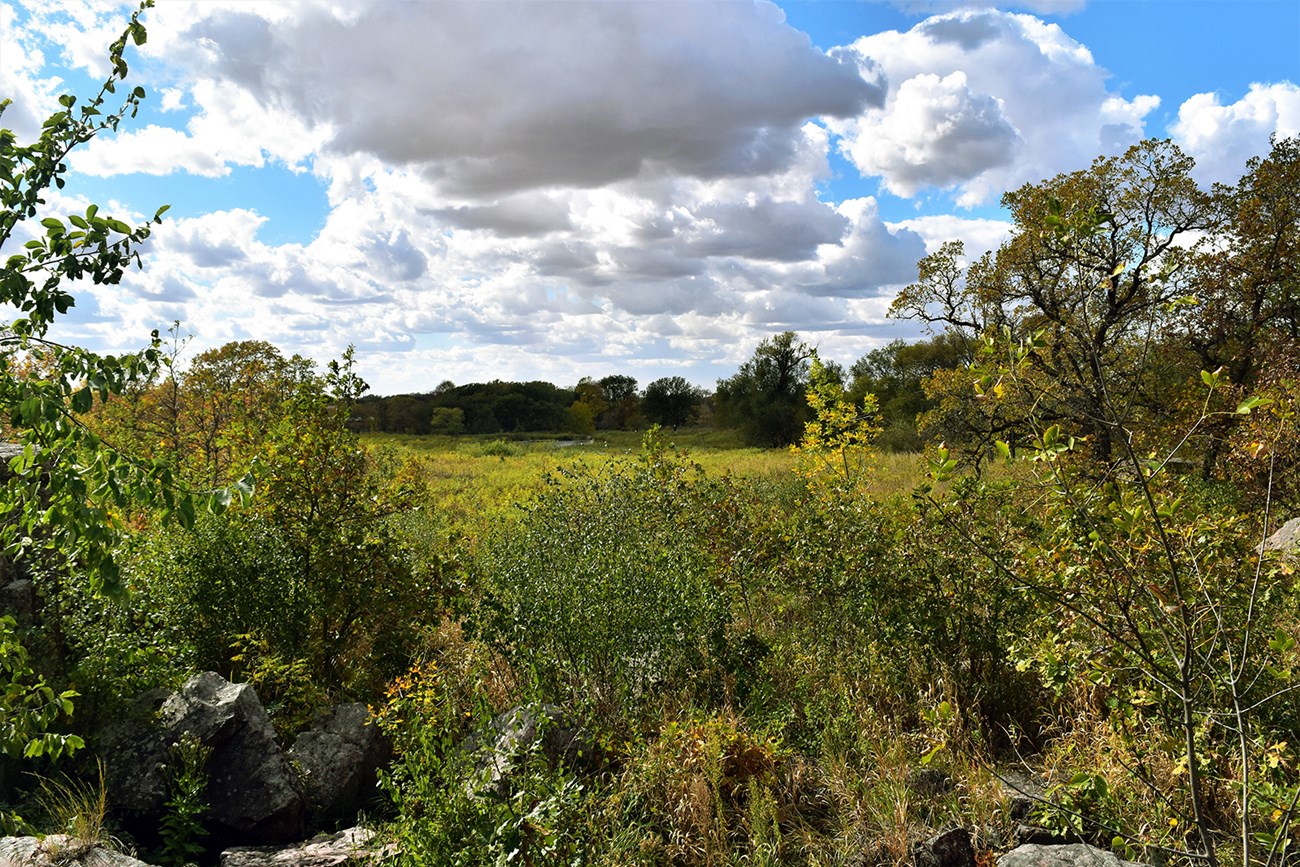Last updated: June 11, 2024
Article
Bird Community Monitoring at Pipestone National Monument in Minnesota, 2022

G. Yellowhawk
Why Do We Monitor Birds?
Birds are an important part of the world we live in. They eat pests, disperse seeds, pollinate plants, and feed us, and birdwatching is a multi-billion-dollar industry. Park interpretive programs often feature birds because of the enjoyment they provide. Birds are also great indicators of environmental change. They serve as the canary in the coal mine for an ecosystem—an early warning system for environmental change.
Habitat at Pipestone National Monument supports a diverse array of bird species, including birds of regional concern. Continued wetland degradation, widespread habitat loss to agriculture and urban and industrial development, and fragmentation of the remaining grasslands threaten many bird species in the region. Scientists in the Heartland Inventory and Monitoring Network measure changes in birds and their habitat to determine the health of bird communities and park ecosystems. During the breeding season, we survey for birds at Pipestone National Monument and gather information about the structure and composition of the park plant communities that birds live in. We compare the trends of birds on the park to bird trends in the region. Together, these data help us determine how bird populations are faring and how birds respond to changes in their habitat. Knowing how birds are doing can help the park take effective steps to restore and maintain bird habitat.
Park Bird Community (2009–2022)
We started surveying for birds at Pipestone National Monument in 2009. In 14 years of surveys, we have found 109 different bird species on the park. Nine-two of these species have the potential to breed in the park. The number of bird species found during surveys and how they were distributed across the landscape was relatively unchanged over the years. The seven species of concern (see table below) in the larger region around the park should be considered when managing breeding bird habitat on the park.
| Common Name | Scientific Name | Code |
|---|---|---|
| Black Tern | Chlidonias niger | BLTE |
| Dickcissel | Spiza americana | DICK |
| Grasshopper Sparrow | Ammodramus savannarum | GRSP |
| Least Bittern | Ixobrychus exilis | LEBI |
| Red-headed Woodpecker | Melanerpes erythrocephalus | RHWO |
| Swainson's Hawk | Buteo swainsoni | SWHA |
| Upland Sandpiper | Bartramia longicauda | UPSA |

N. Barber
Bird Habitat
Pipestone National Monument is in the Prairie Potholes Bird Conservation Region. This region is a glaciated area of mixed-grass prairie in the west and tallgrass prairie in the east. This region contains the most important waterfowl habitat in North America despite extensive wetland drainage and conversion of native grasslands to agriculture. The main breeding range of most dabbling duck species and several diving duck species is in this region, as well as critical breeding and migration habitat for over 200 other bird species, 105 of which can be found in the area in and around Pipestone National Monument. Park habitat is primarily open grasslands and prairie with some woodlands and thick herbaceous vegetation along a stream corridor. These park habitats are important for species of conservation concern in the region.
Trends of Common Bird Species
Fifteen species were observed in sufficient numbers to calculate annual abundances and trends on the park. The Bobolink, American Robin, and Red-winged Blackbird were the most abundant and widespread species on the park. A comparison of regional bird trends with park bird trends were inconclusive. On the park, Common Yellowthroat was moderately increasing, and the other 14 common species had uncertain trends. Regionally, American Robin, Dickcissel, and Yellow Warbler were increasing, and Bobolink, Clay-colored Sparrow, Eastern Kingbird, Grasshopper Sparrow, and Ring-necked Pheasant were declining. The other seven common park species had uncertain trends in the region.

NPS
Species Highlight: Bobolink
The sparrow-like Bobolink is a long-distance migrant that travels about 12,000 miles each year back and forth between North America and southern South America. The northern migration starts in early March and the journey can take more than two months. Boblinks migrate at night, using cues from Earth’s magnetic field to find their way. Their preferred habitat is damp meadows and natural prairies, but these habitats are getting harder to find. Now they are often found nesting in hayfields and making migration stopovers in fields and marshes. Bobolink is one of the most abundant and widespread bird species on Pipestone National Monument, using the grasslands that make up the primary habitat at the park. However, they are declining in the region.
For More Information
Read the full report.Visit the Heartland Inventory and Monitoring Network website.
